Linn County, northeastern Iowa
Sphingidae

Hyles lineata, Marshalltown, Iowa, 6:00 pm, September 23, 2006, courtesy of John Jude.
|
|
Updated as per James P. Tuttle's The Hawk Moths of North America, January 14, 2011 Updated as per personal communication with Tom Jantscher, January 14, 2011; updated March 13, 2012 |

Hyles lineata, Marshalltown, Iowa, 6:00 pm, September 23, 2006, courtesy of John Jude.
This page is inspired by and dedicated to Tom Jantscher who has sent me extensive
collecting data for Linn County. Tom kept excellent and extensive records on his electronic spread sheets.
Such record keeping helps predict/anticipate flights in subsequent years.
The most accurate picture of voltanism, flight season, flight (clock) time, etc.,
comes from keeping such records over many years.
Some species are noted for having cyclical seasons whereby they may seem absent for a couple of years, and then rebound
heartily, only to disappear again a few years later.
Some species are less likely to respond to lights or specific types of lights; others may be uncommon due to lack of natural
host plants or heavy parasite, predator populations.
It is hoped that this checklist, with the thumbnails and notes, will help you quickly identify the moths you have encountered.
A WO?" after the species name indicates that I have no confirmed reports of this species in Linn County, but I (William Oehlke) expect that these moths are present.
Please help me develop this list with improved, documented accuracy by sending sightings (species, date, location), preferably with an image, via email to Bill Oehlke.
Sphinginae subfamily
Lintneria eremitus, nectaring at common milkweed and bouncing bet, Rock Island Preserve, June 28; July 7, 2011, Tom Jantscher
Manduca quinquemaculatus, nectaring at petunia, Noelridge Park, Cedar Rapids, September 4, 2011, Tom Jantscher.
Manduca sexta, nectaring at bouncing bet, Hitaga Sand Ridge Prairie Preserve, September 2, 2011, Tom Jantscher.
Sphinx kalmiae nectaring at bouncing bet, Wickiup Hill Outdoor Learning Center, August 3, 2011; nectaring at bouncing bet, Hitaga Sand Ridge Prairie Preserve, August 12, 12011.
Smerinthini Tribe:
Paonias myops, Rock Island Preserve, June 12, 2011, Tom Jantscher
Macroglossinae subfamilyDilophonotini Tribe:
See Hemaris comparison
to help distinguish the next two species.
|
 | Hemaris thysbe TJ, the Hummingbird ClearwingThis interesting day flier is not confirmed for Marshall. They are widely distributed in the east from P.E.I. to Florida. |
 | Eumorpha achemon WO, the Achemon Sphinx
I suspect it is present. It is fairly often
reported along the east coast from southern New Jersey
to central Maine. |
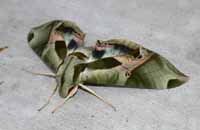 | Eumorpha pandorus TJ, the Pandorus SphinxIf you have Grape or Virginia Creeper nearby, then you probably have this species. I often get asked to identify larvae from areas where they have not previously been reported. |
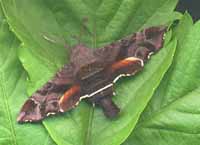 | Amphion floridensis WO, the Nessus SphinixThis day flier is widely distributed. If you have Virginia Creeper, you probably have the Nessus Sphinx. Two bright, distinct, narrow yellow bands are often visible on the abdomen. |
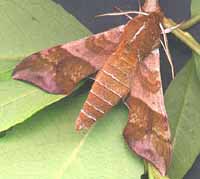 | Darapsa choerilus WO, probalby limited to extreme eastern Iowa, the Azalea SphinxThey are common in New Jersey and common here on Prince Edward Island. You will often see this species listed as Darapsa pholus, especially in older literature. |
 |
Darapsa myron
TJ, the Virginia Creeper Sphinx or the
Grapevine Sphinx |
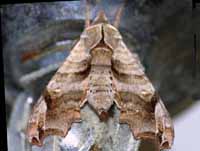 | Deidamia inscriptum TJ, the Lettered SphinxThe moth's outer margin of the forewing is deeply scalloped. The upperside is light brown with dark brown markings. There is a small black and white spot near the tip. The upperside of the hindwing is orange-brown with a dark brown outer margin and median line. |
 | Hyles gallii WO, possibly, but generally more northwesterly, the Bedstraw Hawk Moth or Gallium Sphinx
Some years I see them on P.E.I., some years, I do not. |
 | Hyles lineata TJ; very common, the White-lined SphinxAdults usually fly at dusk, during the night, and at dawn, but they also fly during the day over a wide variety of open habitats including deserts, suburbs, and gardens. |
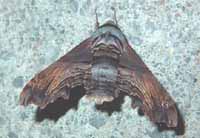 | Sphecodina abbottii WO, the Abbott's SphinxThis moth is very much under reported on USGS. It is a rapid day flier so is probably not in too many collections. Grape is a popular larval host. |
 | Xylophanes tersa TJ, the Tersa SphinxThe upperside of the forewing is pale brown with lavender-gray at the base and has dark brown lengthwise lines throughout. |
This page is brought to you by Bill Oehlke and the WLSS. Pages are on space rented from Bizland. If you would like to become a "Patron of the Sphingidae Site", contact Bill.
Please send sightings/images to Bill. I will do my best to respond to requests for identification help.